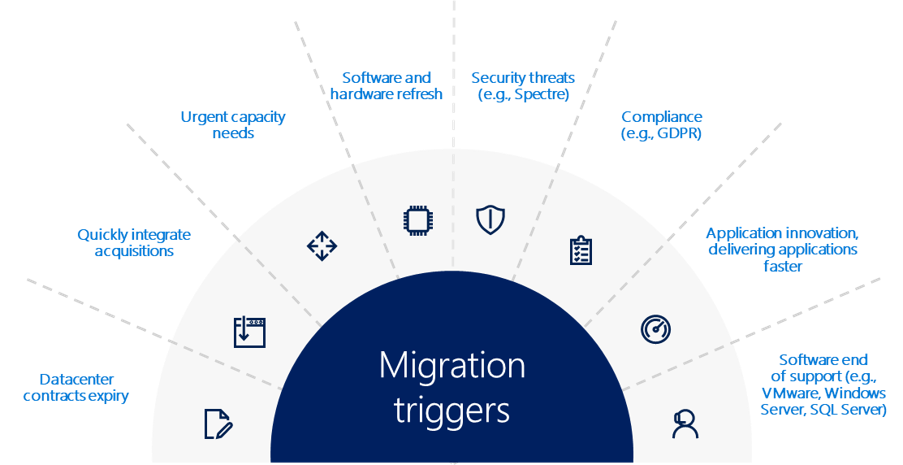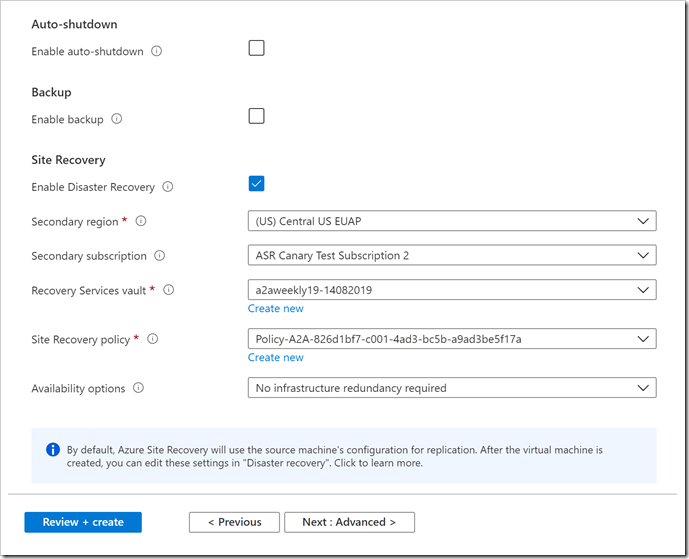Sep 14, 2022
You are almost ready to move your business applications, data, and infrastructure to the Cloud but you still need to be a little bit more confident.
These 4 pillars represent the main value proposition for what differentiates Azure from the competition.


Those are the reasons why customers choose Microsoft, because of the unique value that we provide in a productive, hybrid, intelligent, and trusted cloud.
May 19, 2022
Microsoft has lately announced a new capability in Azure Site Recovery to further improve the Business Continuity and Disaster Recovery posture of Azure VMs – in-line enablement of ASR at the time of VM creation.

This capability helps all Azure infrastructure customers avoid the hassle of separately configuring DR across regions (or zones) after the creation of VMs.
Microsoft recognizes that as the customers move and more business-critical applications to Azure, their resilience is of prime importance.
ASR is a key pillar of Microsoft’s resiliency offering, which allows customers to protect their Azure VMs against regional outages.
Previously, there was no seamless way to enable ASR during the creation of a VM. End customers had to follow through and execute a different workflow to protect the VM from regional (or zonal) outages after the VM was up and running.
With Microsoft latest release, now all end customers will be able to enable ASR while creating a VM. ASR will be one of the VM Management options alongside the ones currently available for configuration – Monitoring, Identity, and Backup, among others.
To get started, a customer can simply head over to the Azure portal. Go to ‘Virtual machines’ and click on ‘+ Add’. Go to the Management tab and select ‘Enable Disaster Recovery’ under ‘Site Recovery’. Make the relevant selections and proceed to create Azure VM. Once the VM is created, replication will be automatically enabled within a few minutes.
It shall be noted that so far, this offering is currently limited to Windows VMs and CentOS, Oracle Linux, and Red Hat Linux VMs. Microsoft also do not support zone to zone (in region) disaster recovery through the Create VM workflow currently.
Mar 4, 2022
Microsoft has announced price increases to the following SKUs starting on March 1st, 2022.
Enterprise SKUs:
- Office 365 E1 is increasing from $8 to $10 per user per month (PUPM)
- Office 365 E3 is increasing from $20 to $23 PUPM
- Microsoft 365 E3 is increasing from $32 to $36 PUPM
- Office 365 E5 is increasing from $35 to $38 PUPM
SMB SKUs:
- Microsoft 365 Business Basic is increasing from $5 to $6 PUPM
- Microsoft 365 Business Premium is increasing from $20 to $22 PUPM
NOTE: Prices for Microsoft 365 E5, Microsoft 365 Business Standard, and Frontline SKUs will not change in the meantime. These price changes will impact all public sector customers worldwide while purchasing channels for nonprofit solutions are not changing at this time.
Dec 31, 2021
The marketplace has changed forever, and the tech market—especially the cloud-based solution and service—is constantly evolving, forcing businesses to take new routes to adapt to these changes. As businesses, our resellers and managed service providers (MSPs) want to remain competitive while capitalizing on what the cloud offers them and accelerating their growth. To smoothly transit into the digital field, they must implement efficient software and migrate their operations, systems, and client databases to a cloud that provides flexibility and a variety of adaptable choices without wasting resources. For that, Microsoft has been shifting and improving its products and programs, and one of them is its cloud service.
Dive into the New Commerce Experience
In 2019, Microsoft launched the New Commerce Experience (NCE) for Azure as a seat-based offer in the Cloud Solution Provider (CSP), a long-term investment, and a new way resellers and MSPs can transact with Microsoft. This program intends to:
- Simplify the licensing process
- Reduce long-term costs
- Offer pricing protection to resellers & MSPs
- Improve and streamline the customer’s purchase and management of Microsoft products
Microsoft has expanded NCE to include Power Platform, Windows 365, Microsoft 365, and Dynamics 365. These products will be available for purchase in the new commerce experience starting in January 2022.
Our resellers & MSPs will get the best benefits
MSPs and resellers will be able to manage their clients’ subscriptions consistently and safely in one cloud. Through efficient integration, NCE promises adaptability of existing and new products, availability of add-ons as external services, and updated APIs for easy-flowing communication between applications and networks. The new commerce platform helps resellers and MSP increase their sales in a more simplified way and build their client database through value-added services to grow and connect effectively. Besides, it minimizes the risk of having customers that don’t commit to a long-term subscription or can’t benefit from a monthly agreement. With this program, revenue forecasts will be more accurate, alleviating the impact of long-term subscription revocations. As a Microsoft indirect provider & distributor, we at BPS want to ensure the best cloud solutions for our MSPs and resellers, offering them smoother purchase and licensing processes that save them time and money in the long term and position them for future growth.
What terms you should consider
To help our resellers migrate their Microsoft licenses from the CSP and other programs to NCE, we are ready to guide them and offer new advantages and promotions that this migration and integration will bring with it. Our NCE launch will be on January 11th, 2022. Be an early bird to benefit from all the amenities this new program will offer because starting March 2022, its products and service prices will go up. Additionally, the yearly plan will have a competitive pricing. It’s your turn now. Migrate to the new commerce platform and expand your systems across the market as a leading company or provider to your customers. With NCE, purchasing, managing, and connecting Microsoft platforms has never been easier.
This is your opportunity to migrate your subscriptions to the cloud with less time and resource wastage. Contact us by filling out this form, and we’ll be more than happy to help you with your process.
Sep 8, 2021
Microsoft is announcing changes to the commercial pricing for Microsoft 365—the first substantive pricing update since they’ve launched Office 365 a decade ago.
This updated pricing reflects the increased value Microsoft has delivered to its customers over the past 10 years.
Take a look at some of the innovations they’ve delivered over the past decade in three key areas—communications and collaboration, security and compliance, and AI and automation—as well as the addition of audio conferencing capabilities that they’re announcing today.
A decade of continuous innovation
Since introducing Microsoft 365 they have added 24 apps1 to the suites—Microsoft Teams, Power Apps, Power BI, Power Automate, Stream, Planner, Visio, OneDrive, Yammer, and Whiteboard—and have released over 1,400 new features and capabilities in three key areas.
→ Communication and collaboration.
In 2020 Microsoft released over 300 new capabilities including Together mode, background effects, large gallery view, raise a hand, live reactions, breakout rooms, live captions with speaker attribution, and Fluid components, just to name a few.
- They introduced a new category of collaborative applications in Teams, empowering people and organizations for hybrid work through deep integrations with Power Platform, Whiteboard, Lists, Planner, Shifts, Forms, and SharePoint. Companies like Adobe, Atlassian, Salesforce, SAP, ServiceNow, and Workday have built apps that deeply integrate with Teams, bringing business processes and functions directly into the flow of work.
- They continue to innovate on both real-time and asynchronous collaboration.
- They introduced real-time collaboration in Word, Excel, and PowerPoint desktop apps while a growing set of capabilities like @mentions, assign tasks, modern comments, and auto-save have streamlined the collaboration experience.
- They’ve added and expanded OneDrive cloud storage and the Exchange Online mailboxes.
→ Security and compliance.
- The cybersecurity landscape is more complex than ever. With the accelerating volume, sophistication, and scale of cyberattacks, security and compliance are a priority for every organization. Since they first introduced Microsoft 365, they have added new attack surface reduction capabilities to help organizations defend against ransomware and other threats.
- They have added capabilities like data loss prevention (DLP) for email and documents, sensitivity labels, and message encryption to help keep important data within the organization.
- They have added powerful compliance capabilities that help organizations reduce risk and respond to increasing regulatory requirements such as Content Search, eDiscovery, and core Litigation Hold. Built-in mobile device management (MDM) and other management tools like Microsoft Endpoint Manager help admins support remote and hybrid workforces.
→ AI and automation.
- Over the past decade, they have infused AI capabilities across our productivity and collaboration applications to help everyone achieve more.
- Across Microsoft 365, they have introduced AI-powered innovations to help users be better writers, designers, and presenters.
- Cloud-powered AI now automatically creates maps, charts, and tables in Excel, and sorts email and removes clutter in Outlook. And AI-powered real-time translation, captions, and transcription make collaboration and communication more accessible and engaging for everyone.
Extending audio conferencing capabilities
- Microsoft is announcing that they will add unlimited dial-in capabilities for Microsoft Teams meetings across our enterprise, business, frontline, and government suites over the next few months. Even as cloud connectivity increases, they know that people join Teams meetings while they are on the go or struggling with a bad internet connection.
- Currently included with Microsoft 365 E5 and Office 365 E5, they have come to see dial-in as an important part of the complete Teams experience.
- Available with subscriptions in over 70 countries and with interactive support in 44 languages and dialects, unlimited dial-in provides peace of mind that users will be able to join their Microsoft Teams meeting from virtually any device regardless of location.
New pricing
- The pricing changes Microsoft is announcing today will go into effect in six months.
- On March 1, 2022, they will update our list pricing for the following commercial products: Microsoft 365 Business Basic (from $5 to $6 per user), Microsoft 365 Business Premium (from $20 to $22), Office 365 E1 (from $8 to $10), Office 365 E3 (from $20 to $23), Office 365 E5 (from $35 to $38), and Microsoft 365 E3 (from $32 to $36).
- These increases will apply globally with local market adjustments for certain regions.
- There are no changes to pricing for education and consumer products at this time.
- As leaders around the world look to empower their people for a more flexible, hybrid world of work, it’s clear that every organization will need a new operating model across people, places, and processes. Microsoft is committed to building on the value they’ve delivered over the past decade to continuously provide innovation that helps our customers succeed and thrive today and well into the future.
Click to learn more
Contact us to learn more [email protected]
Aug 13, 2021
Microsoft Teams is quickly gaining users amid the ongoing shift to Microsoft 365. As the adoption continues to grow, Teams has become an important workload to factor into your migration plan.
In this white paper, you’ll learn:
• Top considerations when preparing to migrate Teams to a new Microsoft 365 tenant.
• What is migrated and what is not.
• Important tips for configuring Teams migration projects.
Download the white paper to power your next Teams migration.
Brought to you by BitTitan®. Helping you make your migrations easy, fast, and secure.











